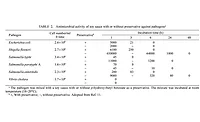Food Safety: Time to check the plumbing
Processors must understand not only what materials are being moved through their plumbing systems but how these lines are designed and laid out.
Do you ever think about how your plant is plumbed? Most plants have lines for wastewater, sewage, fresh water, recycled water and steam. If these systems are properly designed, they include backflow devices, air gaps, steam traps and sample ports. Depending on what the facility processes, there also may be product lines, CIP system lines, holding tanks and chemical waste to deal with. To ensure the integrity of their products, processors must understand not only what materials are being moved through their plumbing systems but how these lines are designed and laid out.
Here are some basic guidelines to ensure food safety and quality:
- An up-to-date plumbing diagram—The plumbing diagram should clearly delineate each of the items mentioned in the first paragraph, as well as the direction of flow, type of line, location of backflow devices and absence of cross-connections between lines. Whenever changes are made to any system, the diagram must be revised and then dated and signed by the plant engineer indicating the diagram is accurate.
- Cross-connections—The plumbing system must have no cross-connections between lines. However, when a beverage or sauce plant uses CIP, there will be one or more cross-connections between the product side and the chemical system. Therefore, the system design and controls must ensure no chance for leakage between the two systems.
- Dead ends or legs—Product and water lines should have no dead ends or dead legs. These are areas that cannot be adequately cleaned or flushed. For instance, emergency eye wash stations are often left unattended for months, even though many are connected to the main plumbing system and are a serious source for dead end contamination. When conducting a spoilage incident at a tomato processor, our team identified a large number of dead legs. Lengths of pipes went nowhere, yet branched off the main processing lines. When we cracked the valves at the end of these, they were loaded with spoiled paste. However, dead legs are not always associated with piping. My colleague was asked to help a beverage processor troubleshoot a problem with off-flavors. He deduced there was probably a dead spot within the water lines and recommended breaking through the floor to examine them. Under the floor, he found a reservoir of stale water that had adversely affected the product’s flavor. He also found the reservoir had cracked, allowing groundwater to enter and contaminate the process water.
- Backflow devices—All water lines should have backflow devices that are highlighted on the plumbing diagram. They can be one-way valves or air gaps. The water main or mains coming into the facility must also have a backflow device. Many states mandate backflow devices on water mains be inspected and tested by a certified plumber at least once a year. These documents must be kept on file.
- Floors and drains—If a food plant has wet processing operations, floors must be designed with an adequate slope or falls to properly carry waste water to the drains. Locating drains directly beneath outlets can minimize the need for cleaning. It also is important to know which drains are most likely cross-connected and to take steps to prevent the drain “P” traps from becoming a source for airborne contamination. Drains may be designed with vapor traps or screens. Sanitizer blocks in drains minimize the potential for microbial growth. Quat rings and quat socks help ensure the drain system below the floor will continually be bathed with an antimicrobial solution.
All food processors must have a program to monitor water quality since water is a primary ingredient or used to mix ingredients. It also is certainly used for rinse downs on equipment that has direct food contact.
The sampling program varies with the water source. Processors using well water should test their water at least once a quarter. These operations should also test water from various locations within the plant. Processors drawing from a city water source should test water from various locations within the plant at least once a year. It is also a good idea to ask the local water district for its test results annually.
Of course, testing without established specifications is a waste of time. The testing program must describe the corrective actions required if the sampling results indicate the water is out of specification, as well as what to do about any product that was affected by the water.
Looking for a reprint of this article?
From high-res PDFs to custom plaques, order your copy today!






